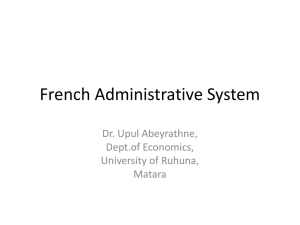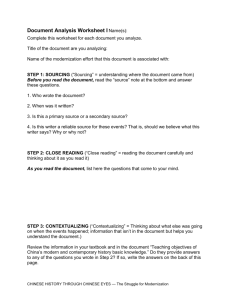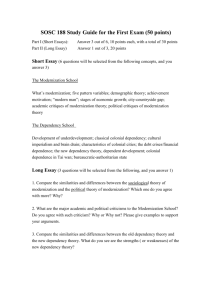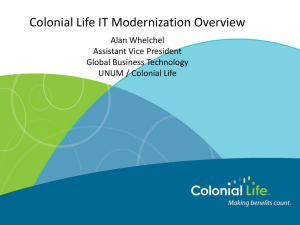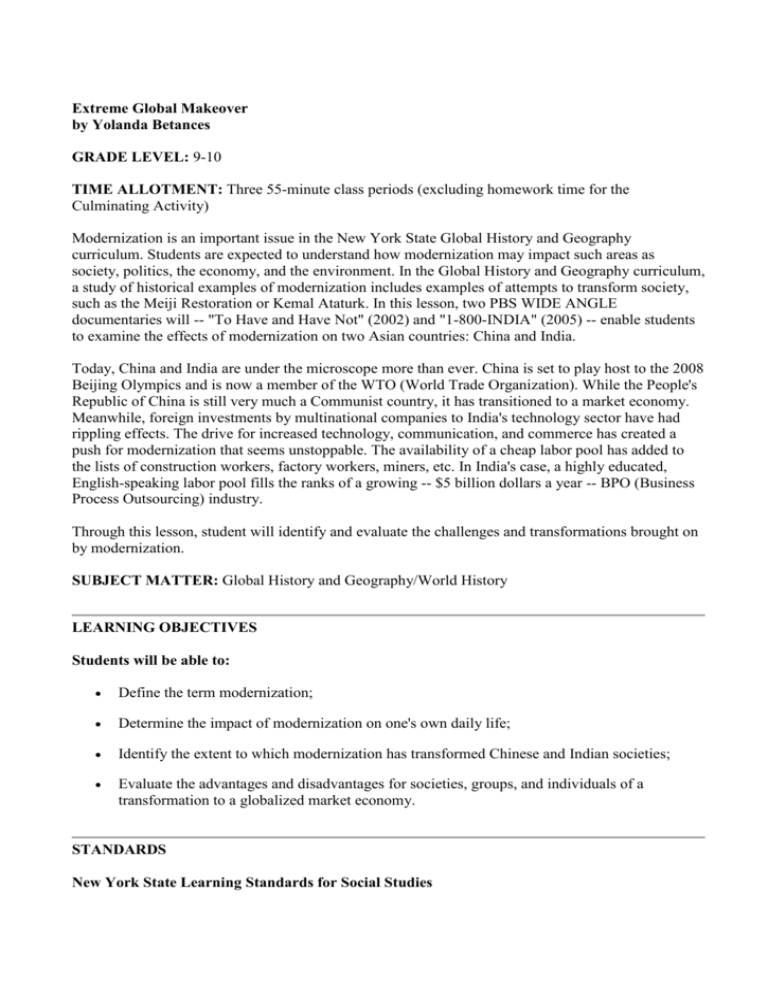
Extreme Global Makeover
by Yolanda Betances
GRADE LEVEL: 9-10
TIME ALLOTMENT: Three 55-minute class periods (excluding homework time for the
Culminating Activity)
Modernization is an important issue in the New York State Global History and Geography
curriculum. Students are expected to understand how modernization may impact such areas as
society, politics, the economy, and the environment. In the Global History and Geography curriculum,
a study of historical examples of modernization includes examples of attempts to transform society,
such as the Meiji Restoration or Kemal Ataturk. In this lesson, two PBS WIDE ANGLE
documentaries will -- "To Have and Have Not" (2002) and "1-800-INDIA" (2005) -- enable students
to examine the effects of modernization on two Asian countries: China and India.
Today, China and India are under the microscope more than ever. China is set to play host to the 2008
Beijing Olympics and is now a member of the WTO (World Trade Organization). While the People's
Republic of China is still very much a Communist country, it has transitioned to a market economy.
Meanwhile, foreign investments by multinational companies to India's technology sector have had
rippling effects. The drive for increased technology, communication, and commerce has created a
push for modernization that seems unstoppable. The availability of a cheap labor pool has added to
the lists of construction workers, factory workers, miners, etc. In India's case, a highly educated,
English-speaking labor pool fills the ranks of a growing -- $5 billion dollars a year -- BPO (Business
Process Outsourcing) industry.
Through this lesson, student will identify and evaluate the challenges and transformations brought on
by modernization.
SUBJECT MATTER: Global History and Geography/World History
LEARNING OBJECTIVES
Students will be able to:
Define the term modernization;
Determine the impact of modernization on one's own daily life;
Identify the extent to which modernization has transformed Chinese and Indian societies;
Evaluate the advantages and disadvantages for societies, groups, and individuals of a
transformation to a globalized market economy.
STANDARDS
New York State Learning Standards for Social Studies
Standards available online at http://www.emsc.nysed.gov/ciai/socst/pub/sslearn.pdf.
Standard 2. World History (commencement)
Performance Indicators:
1. Students:
Analyze historic events from around the world by examining accounts written
from different perspectives.
Understand the broad patterns, relationships, and interactions of cultures and
civilizations during particular eras and across eras.
Analyze changing and competing interpretations of issues, events, and
developments throughout world history.
2. Students:
Analyze evidence critically and demonstrate an understanding of how
circumstances of time and place influence perspective.
Investigate key events and developments and major turning points in word
history to identify the factors that brought about change and the long-term
effects of these changes.
3. Students:
Analyze the roles and contributions of individuals and groups to social,
political, economic, cultural, and religious practices and activities.
Explain the dynamics of cultural change and how interactions between and
among cultures has affected various cultural groups throughout the world.
Standard 3. Geography (commencement)
Performance Indicators:
1. Students:
Investigate the characteristics, distribution, and migration of human
populations on the Earth's surface.
Understand the development and interactions of social/cultural, political,
economic, and religious systems in different regions of the world.
Explain how technological change affects people, places, and regions.
Standard 4. Economics (commencement)
Performance Indicators:
1. Students:
Analyze the effectiveness of varying ways societies, nations, and
regions of the world attempt to satisfy their basic needs and wants by
utilizing scarce resources.
Understand the nature of scarcity and how nations of the world make
choices which involve economic and social costs and benefits.
Explain who economic decision making has become global as a result
of an interdependent world economy.
Understand the roles in the economic system of consumers, producers,
workers, investors, and voters.
Standard 5. Civics, Citizenship, and Government (commencement)
Performance Indicators:
1. Students:
Analyze how the values of a nation and international
organizations affect the guarantee of human rights and make
provisions for human needs.
Identify and analyze advantages and disadvantages of various
governmental systems.
New York State Regents Global History and Geography Curriculum Tie-Ins
Curriculum available online at http://www.emsc.nysed.gov/ciai/socst/pub/sscore2.pdf
Unit Eight: Global Connections and Interactions
A. Social and Political Patterns and Change
1. Human and physical geography
2. Population Pressures and poverty
d. Cycyles of poverty and disease
3. Migration
a. Urbanization
b. Global migration
4. Modernization/Tradition -- finding a balance
5. Scientific and technological advances
b. Improved standard of living
6. Urbanization -- use and distribution of scarce resources
7. Status of women and children
a. Economic issues, e.g., child labor
b. Social issues, e.g., abuse and access to education
Advanced Placement World History Curriculum Tie-Ins
Course Description available online at:
http://apcentral.collegeboard.com/repository/05821apcoursdescworld_4332.pdf
(Requires the Adobe Acrobat Reader)
1750-1914:
Major Developments:
2. Changes in global commerce, communications, and technology
Changes in patterns of world trade
Industrial Revolution (transformative effects on and differential
timing in different societies, mutual relation of industrial and
scientific developments; commonalities)
3. Demographic and environmental changes (migrations; end of the
Atlantic Slave trade; new birthrate patterns; food supply)
4. Changes in social and gender structure (Industrial Revolution;
commercial and demographic developments; emancipation of
serfs/slaves; tension between work patterns and ideas about gender)
Major Comparisons and Snapshots
Compare the causes and early phases of the Industrial Revolution in
western Europe and Japan
Compare the Haitian and French Revolutions
Compare the conditions of women in the upper/middle classes with
peasantry/working class in western Europe
1914-Present:
Major Developments:
1. Impact of major global economic developments (the Great
Depression, technology; Pacific Rim; multinational corporations)
6. Social reform and social revolution (changing gender roles; family
structures; rise of feminism; peasant protest; international Marxism;
religious fundamentalism)
7. Globalization of science, technology, and culture
Developments in global cultures and regional reactions,
including science and consumer culture
Interactions between elite and popular culture and art
Patterns of resistance including religious responses
8. Demographic and environmental changes (migrations; changes in
birthrates and death rates; new forms of urbanization; deforestation;
green/ environmental movements)
Major Comparisons and Snapshots
Pick two revolutions (Russian, Chinese, Cuban, Iranian) and compare
their effects on the roles of women
Compare the legacies of colonialism and patterns of economic
development in two of three areas (Africa, Asia, and Latin America)
MEDIA COMPONENTS
Video:
WIDE ANGLE, "To Have and Have Not" (2002) and "1-800-INDIA" (2005) (selected
clips)
Web Sites:
BUSINESS WEEK, "The Great Migration" (int'l edition)
http://www.businessweek.com/2000/00_50/b3711018.htm
This article discusses the reasons migrants have for leaving their homes for the
cities. Personal stories add to an understanding of perspective.
BBC NEWS, "China's Rural Millions Left Behind"
http://newsvote.bbc.co.uk/mpapps/pagetools/print/news.bbc.co.uk/2/
hi/asia-pacific/4782194.stm
This article discusses how new migrants from the countryside are treated
unfairly as members of an underclass. Migrants suffer countless indignities in
the cities. They also run the risk of losing their land back home as the
government makes deals for development with foreign companies and imposes
stricter guidelines and taxes on rural Chinese.
NEWSWEEK, "This is Really Home"
http://www.msnbc.msn.com/id/8767989/site/newsweek/from/RL.1/
This article discusses the working conditions of illegal migrants and the
violations of human rights in cities. The Chinese government claims migrants
are a major problem.
Unicef, "Migrant Children Beset by Growing Pain"
http://www.unicef.org/china/reallives_3253.html
This Web site shares the stories of migrant children and their anguish when
separated from their parents, who have had to leave for cities in search of work.
Families may be separated for long periods of time.
The Earth Institute South Asia Program
http://www.earthinstitute.columbia.edu/cgsd/advising/india.html
This site offers a short background on the economic growth and development
of industries in India, especially in the technology sector.
Asia Source Interview from ASIA SOCIETY
http://www.asiasource.org/news/special_reports/ahluwalia.cfm
Isher Ahluwalia is currently the Vice Chairperson of the Planning Board of the
Government of Punjab and a member of the National Manufacturing
Competitiveness Council for the Government of India. In her interview, she
discusses India's economic development in the coming years.
MATERIALS
For the class:
Computer monitor or computer connection to television/projector for clip
viewing
Chalkboard, Whiteboard
World (political) map or globe
Sentence strips for "Word Wall" (new vocabulary words/terms, as needed)
For each pair of students:
Computer with Internet access
For each student:
Pen/pencil and writing journal/notebook
Student Organizer # 1: "The Invisible People"
Student Organizer # 2: "Trading Places"
PREP FOR TEACHERS
Prior to teaching this lesson, you will need to:
Bookmark the Web sites used in the lesson on each computer in your classroom, or
upload all links to an online bookmarking utility such as www.portaportal.com.
Preview all of the video clips and Web sites used in the lesson to make certain that
they are appropriate for your students, currently available, and accessible from your
classroom.
Download the video clips used in this lesson onto your hard drive, or prepare to stream
the clips from your classroom. RealPlayer is needed to view the video clips. If your
classroom computer does not have it, download RealPlayer for free at www.real.com.
Refresh your knowledge of the key topics of modernization, fair trade, and
globalization. A few Web sites to consult include www.globalexchange.org),
providing background information on the WTO and its impact on society; and the
World Trade Organization site, at www.wto.org, the site provides a view on the
benefits of membership, the organization's purpose, structure/organization, and
agreements.
Prepare a list of five to ten key vocabulary words/terms that students will encounter as
they view the sites and clips. It may be in the form of a handout with definitions
included. Create a "Word Wall" in your classroom as you add new words/terms.
Organize the order of all handouts and photocopy one for each student.
When using media, provide students with a FOCUS FOR MEDIA INTERACTION, a
specific task to complete and/or information to identify during or after viewing of
video segments, Web sites, or other multimedia elements.
Procedures for Teachers
INTRODUCTORY ACTIVITY:
The following activities will help students to identify the new patterns and challenges
of modernization in the 21st century. Students will understand the concept of the
global village and how technology has fueled trade and economic growth today.
Students will define the term modernization.
25. Provide a "hook" to start a brief discussion. On the blackboard/whiteboard write
the two statements below:
Computers, cell phones, and other technology make life easier and
foster communication worldwide.
Computers, cell phones, and other technology make for a more
demanding lifestyle and for fewer human interactions.
Ask students which statement they agree with more and why. (Students
answers may vary based on their opinions: technology such as cell phones and
the Internet allow for easier, faster communication; you can shop, download
music, play games, travel more quickly, etc.) Ask students what types of
technology they rely upon and enjoy using. (Some students may answer how
they use text messaging and cell phones to keep up with friends and family; use
the Internet to find information for school work or other uses easily and
quickly, or to download music, play video games, and watch movies) Ask how
today's technologies have changed their daily lives. (Some students may
discuss the types of technology they use every day (i.e. cell phones, computer,
the Internet, text messaging, IPod, flat screen TVs, etc.) Ask students where
many of these products that they purchase come from today. (China, Japan,
India, etc.)
26. Ask students to create a working definition for modernization. They should
think about what it means for them to live in a modern world (Students may
suggest modernization has to do with advanced technology and innovation; the
growth of cities; development of new industries; increased commerce and
communication with others worldwide; rapid cultural or societal changes; new
concepts, or ideas). Come up with a definition as a class and write it on the
board. Ask students to think about how modernization might affect the
movement of people. (People move to cities for job opportunities; or move due
to the pressures of population growth, the need for more adequate housing,
need for more schools and other services, etc.)
27. Inform students that technological advances have created a more global society
-- a global village -- interconnected through commerce and trade. Governments
decide how best to meet the needs and wants of their nation -- sometimes this
may involve strict controls over commerce and trade, while other times nations
may allow for a free enterprise system. Business transactions can be done
quickly via computer technology and items can be delivered around the world
in short amounts of time. In industries involving manufacturing, the movement
of goods and services has risen tremendously.
28. Ask students to check the label of the shirt they are currently wearing (where
was the product made?) Students may ask a fellow student for help. (Students
may answer Taiwan, Vietnam, China, the Dominican Republic, India, Mexico,
etc.) Ask students why this clothing may have been manufactured in another
country? How did it get to the store were they bought the shirt? How much did
they pay for the shirt? How much do you think the person who sewed it was
paid? (Students answers may vary; basically students may identify how many
of the clothing items -- and even other products they use -- are made in other
parts of the world; they may say how these products are made in other areas,
because workers in those countries will be paid less than worker in the United
States; manufacturing companies cut costs by moving production overseas or
across the border)
29. Ask the students if they think modernization might bring new opportunities for
some and not for others. Then have the students brainstorm ideas in response to
the following questions, writing their ideas in their notebooks or journals:
What problems/issues may come up because of modernization?
What responsibility do wealthy citizens have to the poor in their own
countries?
(Student answers may vary. Some students may see patterns: ethnic tensions;
changes in traditional roles and values; challenges to trying to balance
modernization and traditional life; widening of gap between rich and poor;
inequity based on race and/ class; students may believe that people should be
able to take care of themselves; some students may feel that modernization
contributes to widening the gap between rich and poor and should be
minimized; help should be provided to assist poorer segment of society to
transform their lives for the better)
LEARNING ACTIVITY #1
30. Explain that to understand the changes that modernization brings, the students
will be examining primary and secondary sources from several different
countries.
31. Provide students with a brief introduction to China: have students locate China
on the classroom/lab map or globe, and discuss why China has adopted
capitalistic economic practices and is now willing to engage in joint ventures
with American and other foreign corporations. Students will probably need to
be reminded of the economic history of Communist China from 1949 and after
the death of Mao in 1976. Inform students that China has now joined the WTO
(World Trade Organization). Provide a brief introduction on WTO.
32. Provide your students with a FOCUS FOR MEDIA INTERACTION, asking
them to identify the name of the worker type that describes Dwanzhi She. How
would they describe this type of worker? PLAY Clip 1, "New Worker Class,"
for the class. Review the focus question with the students. (Dwanzhi She is a
"gold collar" worker; he makes nearly $60,000 a year; he is a manager of a
foreign-owned company and has enough money for a new apartment in an
upscale area of Beijing.) REPLAY Clip 1 to check for comprehension, if
necessary. Ask students what opportunities and advantages Dwanzhi She seems
to have in Beijing (He works for company that does business with foreign
companies. He is highly educated; he speaks English; he just bought a larger,
more modern apartment for his family).
33. Tell students that Dwanzhi She's viewpoint is just one side of the story of life in
Beijing. He considers himself quite the success story in the new China. He will
get his MTV and HBO! Yet, for most people in China the story is very
different. China has a population of 1.3 billion people, and of these an
estimated 900 million are peasant farmers. Tell them that a new migration is
taking place in China -- the greatest migration in modern history. Ask students
in pairs to log on to BUSINESS WEEK, "The Great Migration" (int'l edition) at
http://www.businessweek.com/2000/00_50/b3711018.htm. Here, students will
be asked to read the document and find out about this major shift in China's
rural population. Provide students with a FOCUS FOR MEDIA
INTERACTION: in their notebooks or journals, have them:
Identify five facts about China's migration;
Explain why this migration is happening now;
List possible problems the migration might create.
Review some of the answers as a class. (Move to the cities in search for work;
cannot make a living on farms; China is concentrating on manufacturing;
opening of trade; problems could be overpopulation of cities and lack of
resources)
LEARNING ACTIVITY #2
34. Explain that while rural people in China have viable reasons for moving to
modern cities, in most cases the Chinese government considers it to be illegal
to move from the countryside to the city. In China, people must be registered in
their province of birth. This is called hukou and involves a registration of
residency. It is extremely difficult to get permission to move and register in
another area. Thus, migrants who move to cities in search of work do so
illegally.
35. Tell students that we will now look at this other side of life in Beijing. Provide
your students for a FOCUS FOR MEDIA INTERACTION, asking students to
identify what type of job(s) they see these workers doing and what life is like
for these people. Ask them to jot down the evidence of what they see in their
notebook/journal. PLAY Clip 2, "Migrant Workers," for the class. Ask students
to "turn and talk" with a partner about what they saw and their thoughts on the
lives of migrants. Then ask a few students to report back on what they
discussed with their "turn and talk" partner. (Students saw construction jobs
and a husband and wife working and living in a construction site in conditions
of poverty. The couple is separated from their child and miss him/her and their
village). Ask students to compare this view on life in Beijing to the life
Dwanzhi She is leading in the same city. (Dwanzhi She is wealthy, part of an
upper class, and benefiting from China's new trade policies, while migrant
workers earn very little and do jobs that seem to endanger their health.)
36. Tell students that illegal migrants are found all over major cities of China,
including Beijing, Shanghai, Chongqing, and Guangzhou. Explain that the
students will be investigating the lives of migrants who move to these modern
cities. Students will complete Student Organizer #1: "The Invisible People" for
the segments they have just seen from "To Have and Have Not." Distribute
Student Organizer #1 to the class. Provide students with a FOCUS FOR
MEDIA INTERACTION by asking them to log on to these Web sites and
answer the questions posed on their organizer:
BBC NEWS, "China's Rural Millions Left Behind"
http://newsvote.bbc.co.uk/mpapps/pagetools/print/news.bbc.co.uk/2/hi/
asia-pacific/4782194.stm
NEWSWEEK, "This is Really Home
http://www.msnbc.msn.com/id/8767989/site/newsweek/from/RL.1/
Unicef: "Migrant children beset by growing pain"
http://www.unicef.org/china/reallives_3253.html
Allow approximately 30 minutes for this activity, and continue the activity the
following day, if needed.
(End of Day One of the lesson)
LEARNING ACTIVITY #3
37. Remind students what they have learned thus far about modernization: it may
come in different forms and bring different advantages and disadvantages to
different people. Tell them that migration is also an issue in India, as many
people move to the cities in search of economic opportunities. Have students
locate India on the classroom/lab map or globe.
38. Provide students with some background: explain what BPO stands for
(Business Process Outsourcing); and explain that the economic transformation
India has been experiencing in the last five-ten years due to the growth of
outsourcing industries has been quite noticeable. Include the fact that many
foreign-based companies are interested in the services that the Indian
workforce has to offer in the area of business and technology.
39. Ask students to log on to the following two Web sites:
The Earth Institute South Asia Program, at
http://www.earthinstitute.columbia.edu/cgsd/advising/india.html
Asia Source Interview from ASIA SOCIETY, at
http://www.asiasource.org/news/special_reports/ahluwalia.cfm
Provide students with a FOCUS FOR MEDIA INTERACTION, asking them
read the two texts and to identify evidence that India is growing economically
and will continue to do so. Review student answers as a class.
LEARNING ACTIVITY #4
40. Tell students that they will be seeing segments on the changes the BPO industry
has brought forth on India. Distribute Student Organizer #2: "Trading Places"
to the class. Provide students with a FOCUS FOR MEDIA INTERACTION,
asking them to identify positive and negative effects in the lives of Renuka,
Santosh, Ekta, and Satish Sehrawat. (Note: Tell students that they may see
evidence of positive or negative effects and changes, or both positive and
negative effects for any given person.) PLAY Clip 3, "Transformed
Workplaces," for the class. Check for comprehension. (Renuka, a former
doctor, is now a leader in the mortgage sector of GECIS. She makes more
money here than as a doctor; she has developed more confidence as a speaker
and leads a team of people; she helps other team members. Santosh, who works
with Renuka, is learning new skills, learning English, and developing more
confidence.)
41. PLAY Clip 4, "Shopping Culture," for the class. Check for comprehension. (In
this segment there is evidence of new jobs being created in security,
construction, and real estate, shopping malls, and restaurants. Ekta -- a manager
at a BPO -- is a part of this growing independent class. She has more
disposable income and is shown shopping; she talks about her feelings of
independence and being able to choose how and where to spend her own
money that she earned.)
42. PLAY Clip 5, "Night Transport," for the class. (Here women are shown
needing to work during late-night shifts. The need for safe and reliable
transportation for workers, especially women, had to be arranged. One man,
Satish Sehrawat is a success story. Satish started off with one car and he built a
car service for the BPO. Satish talks about his fleet of cars and his large staff).
Allow for 30-35 minutes for this activity (including discussion time at the end).
REPLAY each segment to check for comprehension, as needed.
LEARNING ACTIVITY #5
43. Have an informal debate on the issue of modernization:
How do the transformations of modernization (including becoming
more involved in the global economy) benefit societies, groups, or
individuals?
How do the transformations of modernization (including becoming
more involved in the global economy) create negative repercussions for
societies, groups, or individuals?
Refer to the evidence that has been viewed and read throughout this lesson based on
China and India. Allow for 25 minutes (or more) for this activity.
CULMINATING ACTIVITY
Ask the students to write a well-organized essay that addresses the theme of
modernization. Include an introduction with a thesis statement, several paragraphs, and
a conclusion. The essay may be assigned as homework. It should address the
following:
Define modernization and discuss to what degree it affects societies, groups,
and individuals.
Based on your study of China and India, provide a specific historical example
of the influence of modernization on the development of each nation.
Describe the positive and negative effects of modernization on people living in
each nation.
CROSS-CURRICULAR EXTENSIONS
Language Arts
Read the article "A New India" by India's prime minister Dr. Manmohan Singh,
who offers his point of view on India's new global era. This article, available at
http://www.ibef.org/artdisplay.aspx?cat_id=84&art_id=6160, first appeared in
THE WALL STREET JOURNAL on May 19, 2005. Write an editorial to THE
WALL STREET JOURNAL as a response.
Science
Research the health problems experienced by migrant workers and write a
report for your school paper. Check out China Labour's Web site, at
http://www.chinalabour.org.hk/public/contents/article?revision%5fid=9100&item%5fid=9099,
as a start on the issue. Find out about how migrants may be subject to working
conditions that affect their health and general well being. Investigate the effects
of pesticides and other toxic materials on workers.
Social Studies
Investigate the issue of labor rights in China and the violation of human rights.
The Web site China Labour Bulletin, at http://www.chinalabour.org.hk/public/contents/article?revision%5fid=18143&item%5fid=9083,
was founded in Hong Kong in 1994 by independent trade unionist Han
Dongfang (who is featured and interviewed in "To Have and Have Not"). Han
Dongfang also has a radio program (from Hong Kong) on Radio Free Asia that
works to expose human rights violations committed against all types of
workers in Mainland China. This Web site offers links to background
information on labor rights, working conditions, imprisoned workers, and
health and safety issues in China today. Research what rights are guaranteed
through the Chinese constitution and what rights are not being respected
(especially for workers). Write a letter to your local congressman about the
need for protection of workers in China, as the United States does more
business there. Research companies like Wal-Mart, McDonald's, and Citibank,
and other companies currently doing business in China. Write a report on the
pros and cons of modernization as the world becomes more global.
Have the students write a thematic essay that addresses the theme of
industrialization. Assign the following:
Historical Context:
Since the 19th century, industrialization has had positive and negative
effects on the lives of people.
Task:
Define the term industrialization.
Select one nation you have studied and discuss two specific
examples of the ways in which industrialization changed the
lives of workers in that nation.
Discuss the response of the workers, reformers, and/or
government to these changes.
You may use any nation from your study of Global History, except the United
States.
COMMUNITY CONNECTIONS:
Invite a labor activist to speak to the class.
Get in touch with group working with migrant workers. Invite the group to participate
in a teach-in on human rights at your school.
Take a trip to Ellis Island (or another immigrant center/museum in your community)
and find out more about early migrants.
© 2006 Educational
Broadcasting Corporation.
All Rights Reserved.
close this window
Funding for WIDE ANGLE: WINDOW
INTO GLOBAL HISTORY is provided by
the Corporation for Public Broadcasting and
the J.P. Morgan Chase Foundation.




